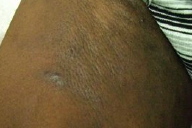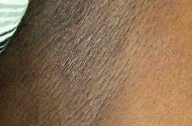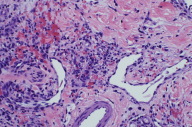A case of Kaposi sarcoma mimicking nephrogenic systemic fibrosis
Published Web Location
https://doi.org/10.5070/D373f3c28pMain Content
A case of Kaposi sarcoma mimicking nephrogenic systemic fibrosis
Sangeetha Venkatarajan MD, Adrienne S Glaich MD, Daniel A Ostler DO, Sylvia Hsu MD
Dermatology Online Journal 15 (12): 6
Department of Dermatology, Baylor College of Medicine, Houston, Texas. shsu@bcm.eduAbstract
Kaposi sarcoma is a neoplasm commonly seen in HIV patients. Cutaneous lesions may vary in presentation between patients. In AIDS-associated Kaposi sarcoma, small red papules or nodules initially present on the face, especially on the nose, and the trunk, that then rapidly spread to other areas. We present an unusual case of AIDS-associated Kaposi sarcoma mimicking nephrogenic systemic fibrosis.
Case report
 |  |
| Figure 1a | Figure 1b |
|---|---|
| Figures 1a and 1b. Indurated plaques over the medial thighs bilaterally and extending over the knees. On palpation, the plaques had a 'woody' firmness. | |
A 36-year-old HIV-positive male with a CD4 count of 341 presented to our clinic with bilateral inner thigh skin hardening that developed over the previous 3 months. The lesions began in the groin and progressively spread down both lower extremities. Associated symptoms included itching and lower extremity pain while walking. The patient's medications included a combination of efavirenz, emtricitabine, and tenofovir (Atripla). Clinical examination revealed indurated plaques over the medial thighs bilaterally and extending over the knees. On palpation, the plaques had a 'woody' firmness (Figs. 1a & b).
 |
| Figure 3 |
|---|
The patient's clinical history and physical exam suggested a differential diagnosis that included nephrogenic systemic fibrosis, morphea, and scleromyxedema. A punch biopsy of the plaque on the right lower extremity was performed. Histopathology demonstrated dermal proliferation of irregular slit-like vascular channels with extravasated erythrocytes consistent with Kaposi sarcoma. Vascular channels infiltrating between collagen bundles, many plasma cells and few spindle cells between slit-like vessels were noted within the dermis (Figs. 2a & 2b). The presence of human herpes virus-8 in the spindle cells was confirmed by immunohistochemistry (Fig. 3). The patient was referred to oncology for further management.
Discussion
Kaposi sarcoma is a neoplasm that is derived from endothelial cells and it usually falls within 4 subtypes: classic, lymphadenopathic, post-transplant Kaposi sarcoma, and AIDS-associated Kaposi sarcoma. AIDS-associated Kaposi sarcoma is the most common AIDS-related neoplasm and is seen in about one-third of patients with AIDS. HHV-8 is involved in the pathogenesis of all variants of Kaposi sarcoma; however, it is not the only factor needed [1]. In AIDS-associated Kaposi sarcoma, HIV-1 Tat protein and inflammatory cytokines also contribute to the pathogenesis, the latter activating HHV-8 and HIV-1 Tat [1, 2, 3].
AIDS-associated Kaposi sarcoma has a highly variable clinical presentation. It typically presents as multifocal small red papules or nodules that are limited to the skin or confined to the oral cavity, lymph nodes, or viscera. These papules typically range in size from a few millimeters to centimeters. They tend to occur initially on the face, especially the nose, and trunk, and spread rapidly to other locations [1, 4].
Interestingly, one case report showed that the clinical presentation of Kaposi sarcoma changed after highly active antiretroviral therapy (HAART) therapy was started. Prior to HAART, the lesions were multinodular with ill-defined borders and histologically resembled nodular stage Kaposi sarcoma. After HAART therapy was initiated, lesions became uninodular, well-circumscribed, and histologically less cellular and surrounded by a dense fibrotic stroma [5]. Unfortunately for our patient, his Kaposi sarcoma continued to progress despite anti-retroviral therapy.
This report describes a patient with Kaposi sarcoma clinically resembling nephrogenic systemic fibrosis. Nephrogenic systemic fibrosis classically presents with extensive thickening and hardening of the skin. It is usually described as having a "woody" texture with papules, plaques, or subcutaneous nodules that typically involve distal or entire extremities and the trunk [6]. A review of the literature found no prior reported cases of Kaposi sarcoma clinically mimicking nephrogenic systemic fibrosis.
References
1. Schwartz RA, Micali G, Nasca MR, Scuderi L. Kaposi sarcoma: A continuing conundrum. J Am Acad Dermatol. 2008 Aug;59(2):179-206. [PubMed]2. Ensoli B, Sturzl, M. Kaposi's sarcoma: a result of the interplay among inflammatory cytokines, angiogenic factors, and viral agents. Cytokine Growth Factor Rev. 1998 Mar;9(1):63-68. [PubMed]
3. Yen-Moore A, Hudnall SD, Rady PL, Wagner RF Jr, Moore TO, Memar O, et al. Differential expression of the HHV-8 vGCR cellular homolog gene in AIDS-associated and classic Kaposi's sarcoma: potential role of HIV-1 Tat. Virology. 2000 Feb 15;267(2):247-51. [PubMed]
4. Di Lorenzo G, Konstantinopoulos PA, Pantanowitz L, Di Trolio R, De Placido S, Dezube BJ. Management of AIDS-related Kaposi's sarcoma. Lancet Oncol. 2007 Feb;8(2):167-176. [PubMed]
5. Eng W, Cockerell CJ. Histological features of Kaposi sarcoma in a patient receiving highly active antiviral therapy. Am J Dermatopathol. 2004 Apr;26(2):127-132. [PubMed]
6. Deng A, Bilu MD, Spillane A, Chwalek J, Surin-Lord S, Brooks S, et al. Nephrogenic systemic fibrosis with a spectrum of clinical and histopathological presentation: a disorder of aberrant dermal remodeling. J Cutan Pathol. 2009 Mar 31. [PubMed]
© 2009 Dermatology Online Journal



